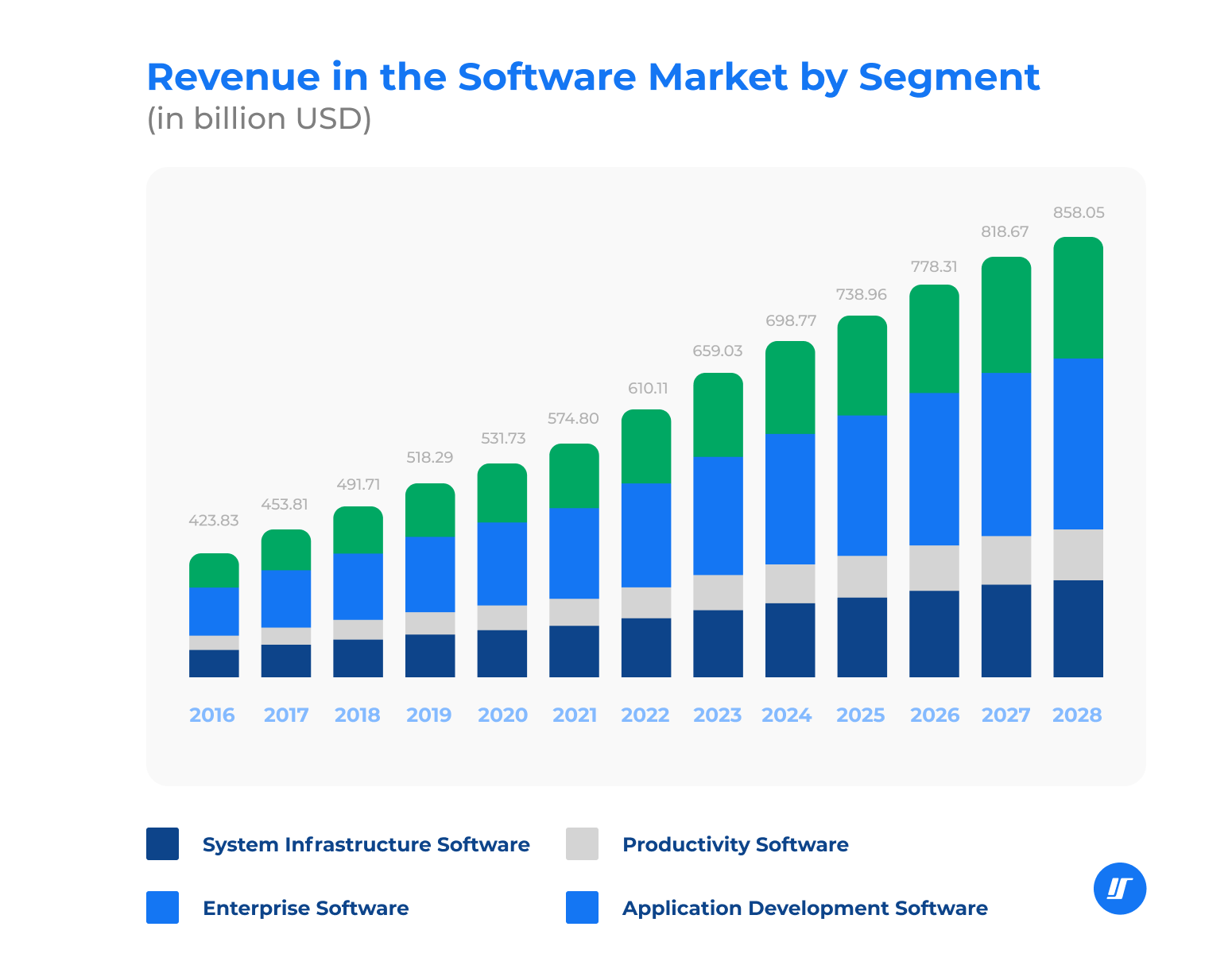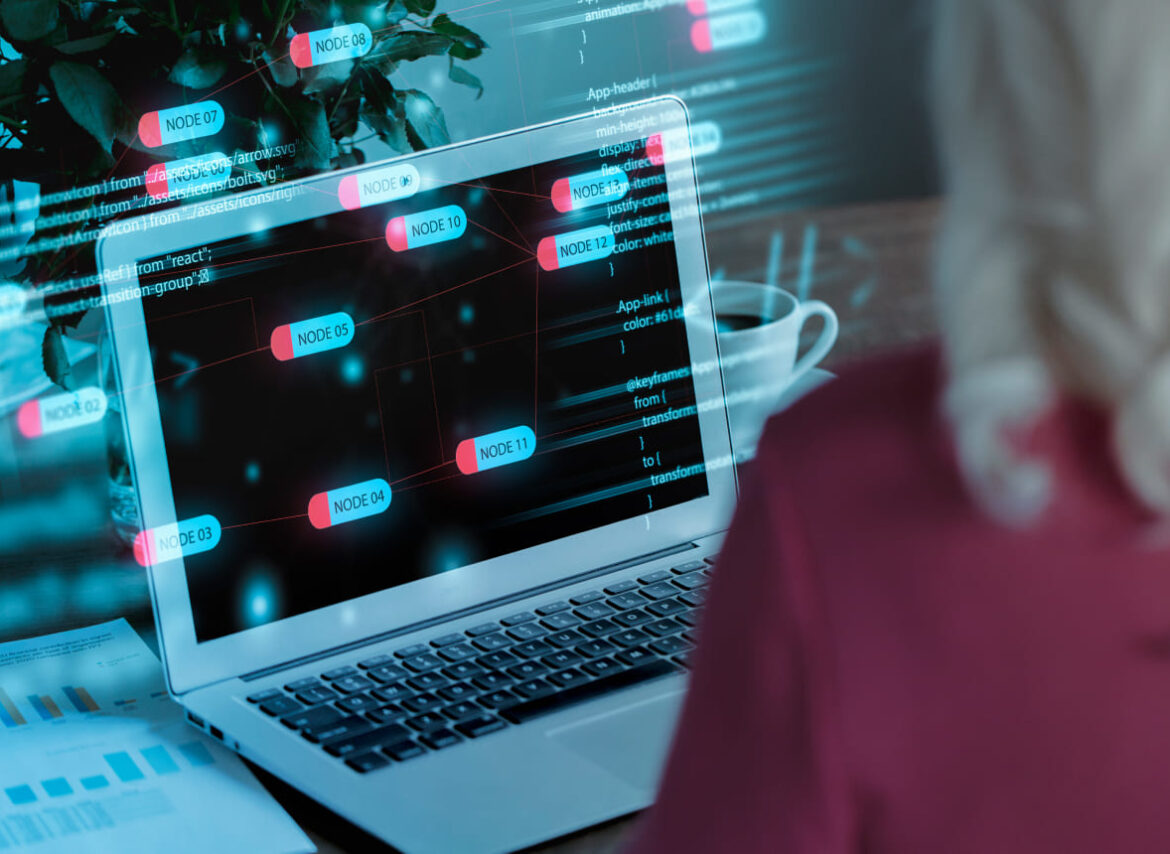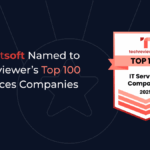Constant development and innovation are at the core of software development. It is constantly evolving and always in flux. Influenced by emerging technologies, global and societal demands, among other factors, software development is one area where people have to keep abreast of software development trends, news, and challenges.
In this article, we will discuss the best software development trends to follow in 2024. Staying updated on the latest software development trends allows industry players and developers to maintain a competitive edge and deliver fresh and cutting-edge solutions every time.
The Evolving Landscape of Software Development
An interesting shift happened globally post-pandemic in 2021, during which the IT sector reentered a growth trajectory after having suffered numerous project delays, cutbacks, and retrenchments during the pandemic. The post-pandemic world saw enterprises big and small recognizing the need to adopt a digital culture. After being caught unprepared when the world went into lockdown, businesses now know better than to stick to the old ways in order to keep the lights on, come what may.
Gartner reports that 91% of businesses have now launched digital transformation initiatives, with 87% of more senior business leaders highlighting that digitalization is a top priority for them. Additionally, 89% of companies have also reportedly adopted a digital-first business strategy moving forward.
In terms of software development, Statista projects that the market is likely to garner revenues reaching $738.96 billion by 2025. Enterprise software is set to dominate the market with a projected market volume of $312.80 billion in 2025, followed by application development software ($193.30 billion), system infrastructure software ($151.20 billion), and productivity software ($81.66 billion).


Statista also predicts that the global software developer population will hit 28.7 million this year. In terms of working arrangements, it appears that 41% of developers have continued to work remotely despite the IT industry prioritizing a return to office culture overall.
What’s Trending in the Software Development Industry in 2024?
Among the top software industry trends in 2024 are technologies like artificial intelligence, machine learning, and cloud computing. Development, Security, and Operations (DevSecOps) practices, as well as microservices architecture are also among the latest trends in software development.
Overall, the current trends in software development are driven by previous changes in the IT sector. As mentioned, the shift to digital has catalyzed a lot of change within the industry and has since transformed the way software is developed, deployed, and maintained.
Additionally, Agile development methodologies have gained wider acceptance, allowing for shorter development cycles amid hybrid and remote work. Just a decade ago, much of this would not have been possible without the increased collaboration among teams and departments facilitated by modern technology today.
As such, many of these software engineering trends are tied to the drive toward increasingly optimized current workflows, facilitating the shift to digital, and continuing to adopt and develop emerging technologies in software development.
Let’s take a closer look at some trending technologies in software development.
1. Increased AI and ML Integration
On top of the list of the latest trends in software development is the recent uptick in the adoption and integration of artificial intelligence (AI) and machine learning (ML) across industries. Both technologies are now widely used by software development companies across the globe to enable data-driven decision-making in businesses as well as to build predictive analytics algorithms.
Regardless of business size, we’ve seen a surge in AI and ML integration all the way from small digital marketplaces to tech giants. This integration is projected to stay on a steady growth course in the coming years. AI, in particular, is expected to surpass half a trillion dollars this year. With a CAGR of 38.1% from 2022 to 2030, the AI market is projected to become a $1.87 trillion-dollar industry by 2030.
In addition to ML, among the top AI development software technology trends include:
- Automated Machine Learning: AutoML will be incredibly useful in simplifying incredibly complex data sets across industries
- Generative AI: Data generated by businesses will soon be used to create original content, including videos, images, and sounds
- Natural Language Processing (NLP): NLP is set to enrich communication between algorithms and users with more advanced natural language understanding
- Ethical AI: Designed to bridge the gap in trust between users and technology by reinforcing cybersecurity measures, boosting confidence in automated systems
- AI-as-a-Service (AIaaS): Companies will begin leveraging cloud-based platforms for a variety of AI services.
2. Application of Blockchain Technology Beyond FinTech
Blockchain technology itself is not new — but this time, tech experts see blockchain disrupting the software development sector in 2024 as it goes beyond fintech.
Businesses from various industries are beginning to understand the usability and value of the technology and are starting to implement it — especially since blockchain offers incredible security thanks to decentralization.
The rise of decentralized systems in different software development sectors like the media, publishing, supply chain tracking, and healthcare is expected to continue on its trajectory moving forward. This is because blockchain’s decentralized nature makes it transparent, virtually unhackable, and incorruptible.
Developers are continuously finding new ways to create custom software development around blockchain technology, driving the blockchain market toward a CAGR of 58.90% with a projected value of $20 billion by the end of 2024.
3. Increased Investment in Progressive Web Apps
Like blockchain technology, progressive Web Apps (PWAs) are also not new — they’ve been around since their introduction in 2015. However, it is now gaining widespread adoption and acceptance, with a CAGR of 31.9% and a projected market value of up to $10.44 billion by 2027.
It also seems that the tech industry has caught up to PWA technology, especially given the exponential increase in mobile usage over the past decade. PWAs offer an opportunity for website owners to improve their website’s user experience and aesthetics by giving them a more app-like feel.
The development scene is seeing more site owners investing in PWAs. Previously, converting to PWAs wasn’t so common, which is why Pinterest made headlines for converting. Following an analysis of areas that caused poor site performance and retention, Pinterest went through an overhaul by rebuilding the website using React and converting it into a PWA. As a result, the site enjoyed a 40% increase in time spent on the platform and 44% more revenue. This was back in 2017.
4. More Companies are Embracing Low-Code/No-Code Development
It’s no secret that developing software can be a lengthy and tedious process. Low-code and no-code development offer developers a much faster and easier way to create apps with minimum coding, allowing teams to ship in record time.
Gartner has previously projected that companies of all sizes will begin to embrace low-code development, with the adoption rate set to exceed 50% through 2026. Experts suggest that the key drivers that will accelerate the adoption of low-code and no-code development are:
- Increase in the number of business technologists
- Growing levels of enterprise-level hyper automation
- Composable business initiatives
“Organizations are increasingly turning to low-code development technologies to fulfill growing demands for speed application delivery and highly customized automation workflows,” shares Varsha Mehta, Senior Market Research Specialist at Gartner.
Basically, these development types allow teams to develop apps with a limited budget and much shorter timeframes. Low code platforms function similarly to purpose-built Integrated Development Environments (IDEs) or platforms that are specifically designed to address varying needs and challenges. Some popular low-code platforms include Mendix, Appian, and Visual LANSA.
Some examples of low-code use cases are:
- Leveraging an existing SaaS infrastructure with customized features according to what a specific business needs
- Transitioning to a cloud-based relational database from traditional spreadsheets
- Converting legacy applications into modern versions
5. The Emergence of FinOps and GreenOps
The cloud computing landscape is currently ushering in the emergence of the FinOps and GreenOps movements, counting them among the latest software development trends. Given the fairly recent upheavals with regard to the way things work, more companies are recognizing how important it is to streamline operations and processes across the board.
After the pandemic, no one wants to get caught unprepared to adapt and keep up with customers’ and the market’s changing demands. Businesses are also putting more effort into sustainability while driving savings and efficiency at the core of business efforts.
In a nutshell, FinOps seeks to drive efficiency across various financial processes, whereas GreenOps focuses on implementing eco-friendly practices in line with long-term value creation. By integrating FinOps and GreenOps, businesses can work to increase their bottom line, comply with regulations, support sustainability efforts, and improve their brand reputation.
6. Serverless Computing
Serverless computing, also called Function as a Service (FaaS), allows developers to create applications and services without having to manage infrastructure, leading to better efficiency and cost savings.
Among the leading providers are Azure Functions, AWS Lambda, and Google Cloud Functions. For example, streaming provider Netflix has started using AWS Lambda for certain functions within the platform.
Lambda takes care of tasks such as user authentication, encoding videos, and backend processes. This allows Netflix to scale its resources based on demand without needing to manage servers while providing a smooth user experience and cutting costs.
Spotify, on the other hand, uses Google Cloud Functions to handle tasks such as user authentication, processing user-generated content, and backend tasks for music recommendation algorithms.
7. Greater Reliance on Distributed Computing
Distributed computing is another software development trend that is gaining more popularity in 2024. Distributed computing is a way of data sharing by way of different computer servers connected as a group.
As such, large volumes of data that may be too much work for just one server can be spread across multiple servers and thus be processed much more quickly. Distributed computing allows applications to scale accordingly by just adding servers as needed.
Overall, distributed computing improves performance while minimizing costs. Best of all, a system failure in one server will not affect others — allowing for continuity of operations should something arise.
8. Increased Focus on Cybersecurity with DevSecOps
Development + Security + Operations is DevSecOps. In a nutshell, it’s an automation, platform design, and culture approach. It also integrates security as a crucial and shared responsibility throughout the IT lifecycle.
Many more companies are beefing up their cybersecurity programs with DevSecOps, as it focuses on built-in security over security measures built around data and apps. DevSecOps prioritizes early detection of potential risks and fixing these vulnerabilities before they become more significant issues.
DevSecOps breaks down silos between different teams and puts security at the forefront of all commit and pull requests. Compliance is also of utmost importance in the DevSecOps pipeline, and as such, compliance and security checks are always integrated.
9. Ushering the AR/VR Era
AR and VR are no longer confined to just video games and entertainment. For clarity, whereas AR uses real-life elements supplemented with computer-generated content to create an interactive and dynamic user experience, VR is entirely a virtual, immersive simulation.
More and more businesses are seeing the value of these technologies in 2024 and are using them to create real-world simulations for customers and stakeholders, as well as interactive training programs for employees.
For example, large pieces of tech or machinery that cannot realistically be brought into a trade show fair can be rendered via VR or AR, allowing customers and stakeholders to “experience” what it’s like. The same applies to prototypes that may not yet be ready but already have a defined blueprint.
Also, training programs can be enriched with demonstrative and hands-on training through VR and AR, allowing staff to perfect muscle memory without even having to operate the real thing right away (like heavy machinery and other equipment).
10. Microservice Architecture
Microservices architecture in software development refers to a different approach to software development. Microservices focus on creating single-function modules with specifically defined interfaces and operations.
This is in line with Agile and DevOps and has really picked up in recent years. Microservice architecture is small in scale and independent, allowing smaller development teams to write and maintain services much quicker and more efficiently.
In such an architecture, each layer of service is separated from the codebase, making it easy to manage. This allows developers to update and manage an app or service without needing to rebuild or redeploy the whole thing.
11. AI in Healthcare
AI offers to the medical sector what a Deloitte study revealed to be among the top three goals of AI in healthcare: Improved efficiency, lower costs, and enhanced products and services.
One of the practical ways AI can help support these goals is by developing AI software that can improve symptom analysis through patient data, automatically detect medication errors, and automate administrative tasks overall.
Venture capitalists have also reportedly invested over $8.5 billion in the top 50 healthcare AI firms, highlighting the current importance of AI in healthcare.
12. NFT Tokens in Cryptocurrency
NFTs, or Non-Fungible Tokens, are digital elements connected to the Blockchain. They are called such because they are non-fungible, meaning that they’re completely unique and not interchangeable.
No two NFTs are similar, and this concept has pushed it to become a significant trend, especially concerning Blockchain-based payments in recent times. It is already one of the most common payment methods in software development outsourcing, possibly because it allows for fast, secure, reliable, and transparent payment between people.
NFTs are projected to grow exponentially and reach $211.7 billion by 2030, with a growth rate of 34.2%. NFTs are built on smart contracts or self-executing lines of code, allowing for speedy and secure transactions.
13. React Native Continues to Thrive
The programming React Native has emerged at the top of the hybrid development market. This is because it allows developers to create high-quality cross-platform applications using a single codebase.
This allows teams to work much faster and more efficiently, cementing its status as an important tool for businesses looking to maximize their reach and streamline workflows.
14. The Switch to 5G Technology
Alongside the rapid 5G rollout — experts predict that over 1.4 billion devices, or 15% of the global total, will be connected to this network by 2025.
This is because 5G is more efficient than 4G. It is a new network architecture that seeks to redefine how people communicate and connect digitally, leading to enhanced user experiences. The 5G architecture is also expected to accelerate the growth of innovative technologies like the Internet of things and Artificial Intelligence (AI).
15. The Popularity of IoT is on the Rise
The widespread adoption and growth of smart devices calls for more IoT solutions, ushering in an era of more connectivity — allowing people to bridge the gap between the physical and digital.
According to research, the global IoT market is projected to grow to $650.5 billion by 2026 and at a CAGR of 16.7%. This is because IoT has found several applications due to the rise of related technologies like AI, ML, automation through edge computing, and more.
City governments exhibit another welcome use of IoT solutions — from enhancing security to traffic congestion reduction, the goal is to streamline urban living and optimize city infrastructure with technology. Healthcare IoT gadgets are also facilitating early disease detection, providing people with better chances of recovery and healing.
16. Python Developer Demand Expected to Rise
Machine learning and data science continue to dominate several industries, causing an increased demand for experienced Python app developers. Python is often considered the ultimate Swiss knife of programming languages, as it is capable of performing numerous tasks and handling complex jobs.
Python also continues to remain versatile and relevant. From web design and app development to machine learning models, the programming language allows developers to complete projects efficiently. Among the key areas in which Python may experience an uptick in usage are game development, AI and ML applications, IoT, web and mobile apps, and automation and robotization.
17. Web 3.0 Continues to Evolve
It is said that Web 3.0 holds the future of the Internet, as it is continuously being propelled by the latest technologies and software development processes.
The three basic IT architecture tiers of Web 3.0 are:
- Interaction: This refers to the content, hardware, and software that users communicate with
- Computation: This makes up the logic to enable the interaction between users and the above elements
- Information: Refers to the data and structure required for computing functions to be done accurately and efficiently.
Web 3.0 apps are characterized by complexity and interactivity and go a step beyond the static pages we got used to in previous web versions. JavaScript development is used to create Web 3.0 apps, making them both dynamic and responsive.
Currently, Web 3.0 applications are already available on desktop browsers and some high-end mobile devices like smartphones with OLED panels. However, tech experts anticipated a much higher volume of Web 3.0 apps and compatible devices moving forward.
18. Cloud-Native Technologies Continue to Evolve
Cloud-native technologies and cloud-based architectures allow one to design, construct, and operate cloud-developed workloads, taking full advantage of the cloud computing model. Cloud-native prioritizes agility and better speed, allowing organizations to create strategic solutions that can support their business growth.
In 2024, cloud-native technologies will continue to evolve and increase in usage as cloud-native implementation allows developers to develop and execute scalable applications. Cloud-native apps work across modern and dynamic work environments, such as private, public, and hybrid clouds. This also covers microservices, containers, immutable infrastructure, service meshes, and declarative APIs.
Additionally, with cloud-native stacks like DevOps and GitOps, developers can easily use continuous innovation and continuous delivery (CI/CD) to test applications while simultaneously pushing new code into production.
By leveraging cloud-native development, organizations can bank on built-in scalability and match any demand profile without investing in added infrastructure design or provisioning. Cloud-native development also allows developers to choose from various tools instead of being limited to in-the-box options.
19. The Advent of IoB (Internet of Behavior)
Personalization is an important driver of success in any business. The more effective your service is, the more your users will adapt their approach to your infrastructure. The Internet of Behavior (IoB) brings to the table important data like user behaviors, interests, and preferences from Big Data, BI (Business Intelligence), and CDPs.
Pulling from wearable devices, smart household electrical gadgets, and individual internet activity, IoB reveals valuable information on user behavior and their interests. IoB facilitates easier tracking, merging, and evaluating large volumes of data from various online activities and personal behaviors.
This includes things like social media habits and even commercial transactions. IoB is a little behind IoT in terms of momentum and adaptation. However, as consumers continue to gravitate toward personalization and businesses seek ways to give users a customized (yet still on-brand experience), it is highly likely that IoB will gain greater momentum.
IoB is already being used by companies and startups. YouTube, for example, has begun to provide viewers with a more customized feed, much like Facebook and other social media platforms. Overall, IoB can help businesses resolve challenges that may hinder them from closing sales and acts much like consumer surveys without needing to expressly ask consumers about their preferences.
20. Edge Computing
Edge computing is called such because it processes data closer to the “edge” of the network or where it’s created—in an effort to greatly reduce latency and bandwidth use. According to research, the global edge computing market is expected to grow at a CAGR of 37.4% by 2027. Fortune Business Insights projects that the global edge computing market will grow from $15.96 billion in 2023 to $139.58 billion by 2030.
Edge computing is particularly crucial for IoT devices because they generate huge amounts of data. It can also improve privacy and security as data is kept locally. This is in opposition to centralized cloud platforms, which are not the closest to data sources.
An increasing number of businesses have started to shift their analytics and decision-making from centralized cloud platforms to the edge.
This trend is largely driven by the observation that data captured at the edge often requires processing, storage, and analysis on-site, and it can’t always be done via cloud-based applications due to cost implications, uptime constraints, and latency issues.
Edge computing is an evolution of on-premise computing. It is technically an IT architecture that processes client data at the network’s edge, closest to the site of capture. By bringing computing closer to such data sources, edge computing is able to reduce latency and enhance real-time data processing capabilities.
Edge computing is particularly useful for applications that require immediate data analysis, such as autonomous vehicles and smart city technologies. In the field of healthcare, edge computing also ensures utmost data privacy and allows for AI-based real-time monitoring and close analysis of the patient’s condition.
When applied in practice, this technology can transform traffic management by regulating traffic lanes, optimizing bus schedules, and even guiding autonomous vehicle flows.
21. Quantum Computing
The principles of superposition and entanglement are among the most fundamental quantum-mechanical phenomena used in quantum computing for data operations. Quantum computing is an even more advanced form of computing that uses quantum bits (called qubits) instead of classical bits.
The capacity to execute specific calculations much faster than classical computers is one of the primary advantages of quantum computing. As such, it has the potential to greatly revolutionize how machines solve intricate computational tasks, including cryptography, optimization, machine learning, and molecular simulation.
Quantum computing can be particularly useful in sectors like energy, finance, healthcare, and logistics, especially to address computational challenges that may be deemed too complex (even insurmountable) for classical computers. This includes simulating complex system behavior, decryption of cryptographic codes, and optimizing logistics networks that are incredibly large in scale.
That said, the development of quantum computing technology is still in its early stages. Researchers are currently actively engaged in building quantum computers and refining quantum algorithms, as well as software tailored for their operation. Leading companies are currently developing software to make quantum computing more accessible to a wider audience.
These include tech industry leaders like IBM, Google, Microsoft, D-Wave, and Amazon. IBM is ahead of its peers with Quantum System One and Two, which uses powerful processors of up to 127 qubits. Microsoft, on the other hand, is focusing on topological qubits and integrating them into the already-up Azure cloud platform for wider accessibility.
Conclusion
Current software development trends are driven by the massive shift to digital, as well as the convergence between AI and new technologies that seek to improve our ways of working and living.
Significant leaps are being made in the field of groundbreaking technologies like the Internet of Things, Internet of Behavior, and Web 3.0, as well as quantum computing — all of which can catalyze even more advancements especially when applied to city traffic, healthcare, finance, and other sectors.
Additionally, technologies that have been around for a while are now finding a firmer footing and are enjoying wider adoption. These include blockchain technology, NFTs, and PWAs, as companies see more use cases and security advantages.
Trusty programming languages like Python and JavaScript remain at the forefront of software development despite these trends. Still, newer ways of doing things — like serverless computing, edge computing, DevSecOps, FinOps, and GreenOps — are coming to the fore as workplaces continue to evolve and create new demands that developers need to address.
Your Partner in Development
Intellectsoft prides itself on a comprehensive approach that includes consulting, engineering, and support services. As your software solutions provider, we can offer custom AI, Blockchain, IoT, mobile, and other solutions depending on your needs.
Our team of experienced developers can handle projects of any type and difficulty. From simple web and mobile apps to cloud-based enterprise-level products, we’ll take your vision from the idea board and make it a reality. Get in touch with us today to consult with an expert!
Subscribe to updates
Source link











